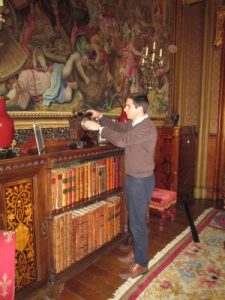Ages ago, I saw a programme on Granada TV about Chatsworth and was impressed by everything I saw, but I particularly remember a shot of the house clock winder walking down a long corridor with a large ring of clock keys jangling from a ring. I was slightly surprised that such a house, especially a very large one where a lot of people already worked, needed a clock winder as well.
When we had restored all the clocks (26 in all, excluding the Turret clock described earlier) at Eastnor, I was confident that our house team would be able to do the job or that I could fill in when they were not available. For some of the time, it worked all right. There was a soothing tick-tock in the rooms where the clocks were, and when they reached the hour, there was a satisfying cascade of bells, perfect synchronisation obviously not being possible.

But as our business grew, I noticed that the winding job, quite rightly, was not being given priority over the needs of customers and visitors. Clocks stopped, and sometimes, annoyingly, eleven hours behind the correct time, so it took a while to wind them forward. Going away for an hour to avoid the chore often led to the job being forgotten.
I then accepted that a clock winder was necessary after all. We placed an advertisement in the window of the jewellery shop in Ledbury, Gaynans where Peter Judge, the owner and resident clock and watch repairer, told me he had started his career winding clocks in a big house in Cheshire, so he knew what we needed. There was not an overwhelming response, but luckily Chris Powell, an excellent clock repairer with a workshop on the estate, said he would do it, probably, he said, because he did not want anyone else to.
He started work in the spring, and it has gone very well as he is monitoring performance and making adjustments as he goes along. The image shows Chris at work in the Gothic drawing Room. I hope our guests observe that all our clocks are running as I certainly do.
JH-B 21st December 2012
Our first major restoration project followed the damage caused to our towers by the hurricane in January 1976. The force of the wind blew some of the battlements off the tops of three of them, and there was no option other than to repair them. We managed to get by over the following ten years patching up the roof as we went along, but in 1986, the keep stonework that had suffered from many wet and freezing winters began to show signs of collapse, so we started on a new phase of major work.
My mother instructed Ian Stainburn a local architect based in Ledbury with experience of similarly challenged ecclesiastical buildings and dealing with English Heritage a grant was offered, and work started before there was any serious damage. We then went on to replace crenelations that had been removed from the tops of the four chimney towers, which restored the original appearance of the roofscape in a very satisfactory way. In further phases, we replaced most of the roofs across the rest of the house, using lead where previously short-term, but effective, asphalt had sufficed. We also removed, with some regret because it had been so effective, asbestos cement corrugated sheeting, which had been very low maintenance and invisible behind the parapets, and put slates in its place.
Much of this high-level and high-cost work has been grant aided by English Heritage and, latterly, by the Country Houses Foundation. Although there will always be more to do, we decided, after 25 years during which we had also restored much of the interiors, to apply for a Georgian Group award in the category: Restoration of a Georgian Country House, sponsored by Savills. The timing coincided with Ian Stainburn’s retirement, and at a ceremony held at Christie’s in London; we shared first place with Boconnoc in Cornwall.
We were delighted to have been recognised in this way and with the report in Country Life and the article on 28th November. It has been hard but satisfying work; we hope the house is now in a condition in which it can sustain itself in the future as long as we keep it well maintained.
James Hervey-Bathurst 10th December 2012